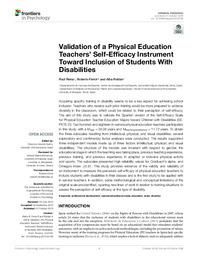Por favor, use este identificador para citar o enlazar este ítem:
https://hdl.handle.net/11000/30820Registro completo de metadatos
| Campo DC | Valor | Lengua/Idioma |
|---|---|---|
| dc.contributor.author | Reina, Raul | - |
| dc.contributor.author | Ferriz, Roberto | - |
| dc.contributor.author | Roldan, Alba | - |
| dc.contributor.other | Departamentos de la UMH::Ciencias del Deporte | es_ES |
| dc.date.accessioned | 2024-01-30T10:13:14Z | - |
| dc.date.available | 2024-01-30T10:13:14Z | - |
| dc.date.created | 2019-10-01 | - |
| dc.identifier.citation | Frontiers in Psychology, vol. 10, 2169, 2019 | es_ES |
| dc.identifier.issn | 1664-1078 | - |
| dc.identifier.uri | https://hdl.handle.net/11000/30820 | - |
| dc.description.abstract | Acquiring specific training in disability seems to be a key aspect for achieving school inclusion. Teachers who receive such prior training would be more prepared to address diversity in the classroom, which could be related to their perception of self-efficacy. The aim of this study was to validate the Spanish version of the Self-Efficacy Scale for Physical Education Teacher Education Majors toward Children with Disabilities (SE-PETE-D). Two hundred and eighteen in-service physical education teachers participated in this study, with a Mage = 38.06 years and Mteaching experience = 11.72 years. To obtain the three subscales resulting from intellectual, physical, and visual disabilities, several exploratory and confirmatory factor analyses were conducted. The results supported three independent models made up of three factors (intellectual, physical, and visual disabilities). The structure of the models was invariant with respect to gender, the educational stage in which the teaching was taking place, previous teaching experience, previous training, and previous experience in adapted or inclusive physical activity and sports. The subscales presented high reliability values for Cronbach’s alpha, and Omega’s index ≥0.81. This study provides evidence of the validity and reliability of an instrument to measure the perceived self-efficacy of physical education teachers to include students with disabilities in their classes and is the first study to be applied with in-service teachers. In addition, some methodological and conceptual limitations of the original scale are identified, opening new lines of work in relation to training situations to assess the perception of self-efficacy or the type of disability. | es_ES |
| dc.format | application/pdf | es_ES |
| dc.format.extent | 10 | es_ES |
| dc.language.iso | eng | es_ES |
| dc.publisher | Frontiers Media | es_ES |
| dc.rights | info:eu-repo/semantics/openAccess | es_ES |
| dc.rights | Attribution-NonCommercial-NoDerivatives 4.0 Internacional | * |
| dc.rights.uri | http://creativecommons.org/licenses/by-nc-nd/4.0/ | * |
| dc.subject | professional development | es_ES |
| dc.subject | special educational needs | es_ES |
| dc.subject | education | es_ES |
| dc.subject | scale | es_ES |
| dc.subject | diversity | es_ES |
| dc.subject.classification | Educación física y deportiva | es_ES |
| dc.subject.other | CDU::7 - Bellas artes::79 - Diversiones. Espectáculos. Cine. Teatro. Danza. Juegos.Deportes | es_ES |
| dc.title | Validation of a Physical Education Teachers’ Self-Efficacy Instrument Toward Inclusion of Students With Disabilities | es_ES |
| dc.type | info:eu-repo/semantics/article | es_ES |
| dc.relation.publisherversion | https://doi.org/10.3389/fpsyg.2019.02169 | es_ES |

Ver/Abrir:
Reina et al._2019_Frontiers in Psychology.pdf
1,72 MB
Adobe PDF
Compartir:
 La licencia se describe como: Atribución-NonComercial-NoDerivada 4.0 Internacional.
La licencia se describe como: Atribución-NonComercial-NoDerivada 4.0 Internacional.
.png)